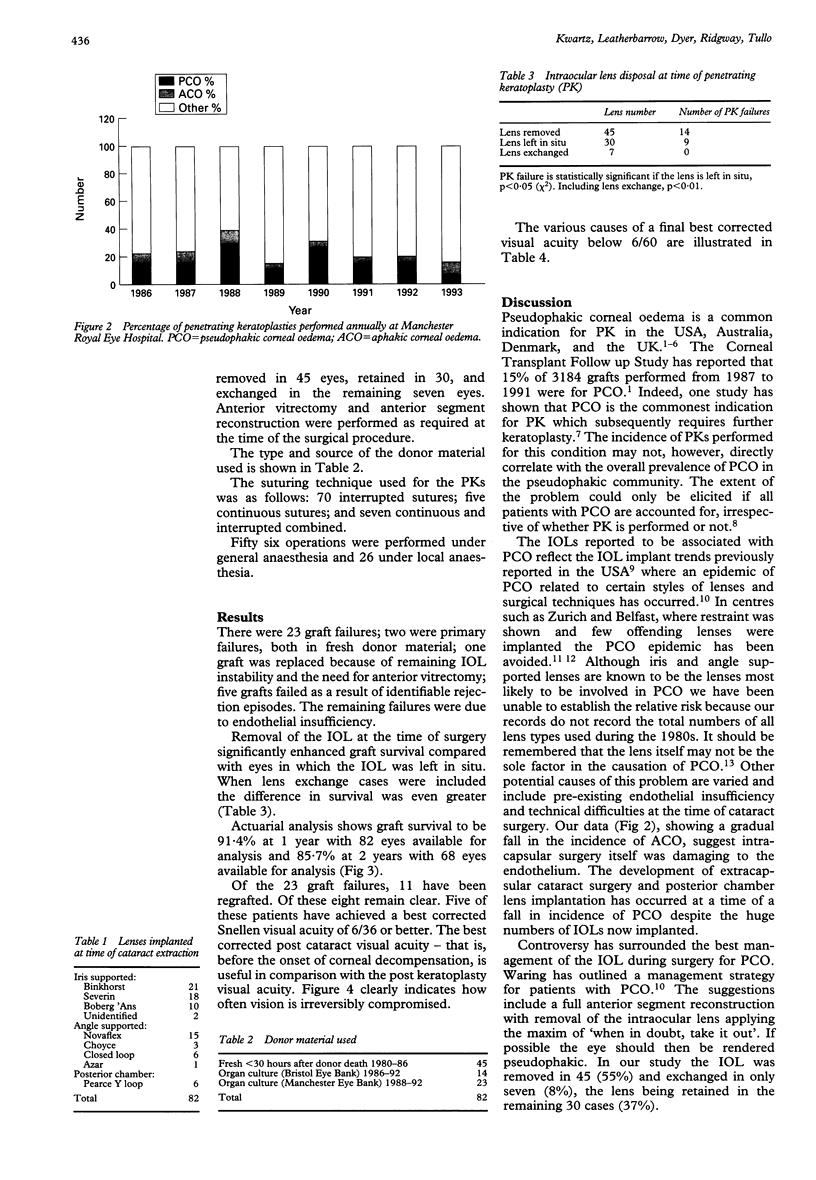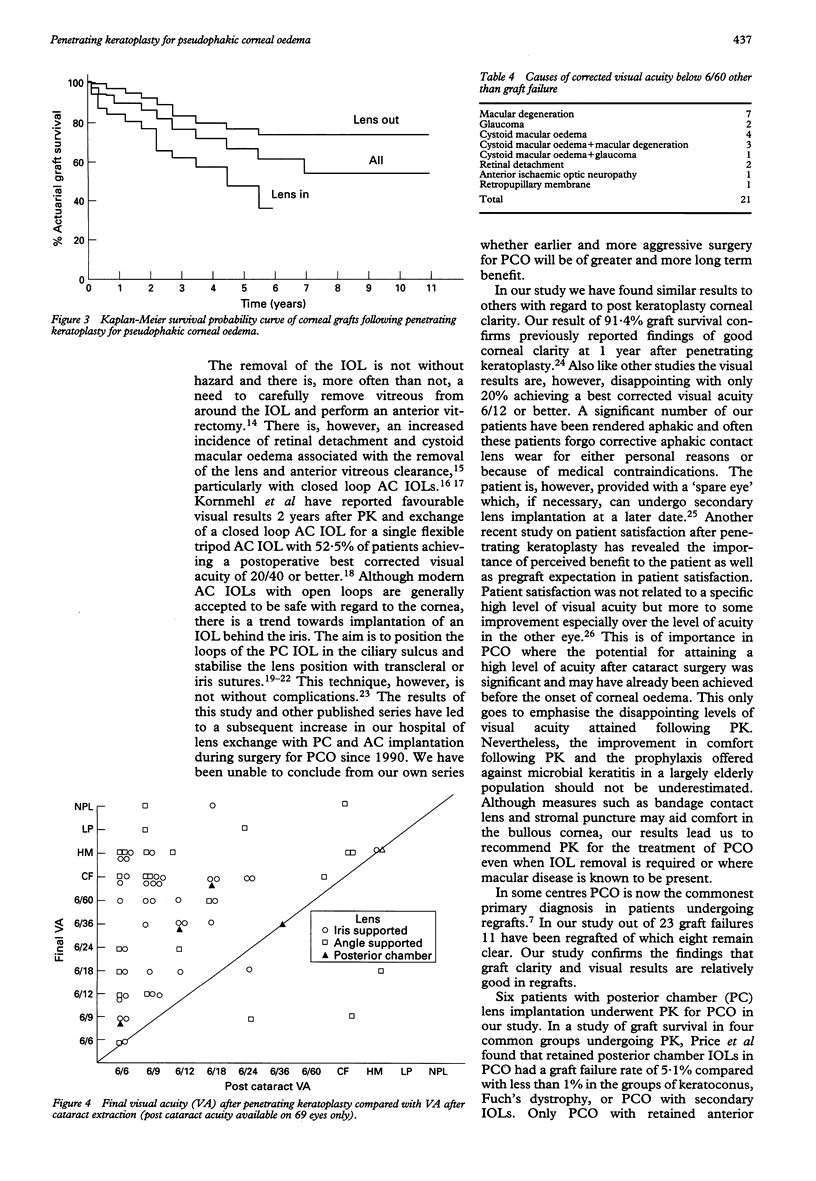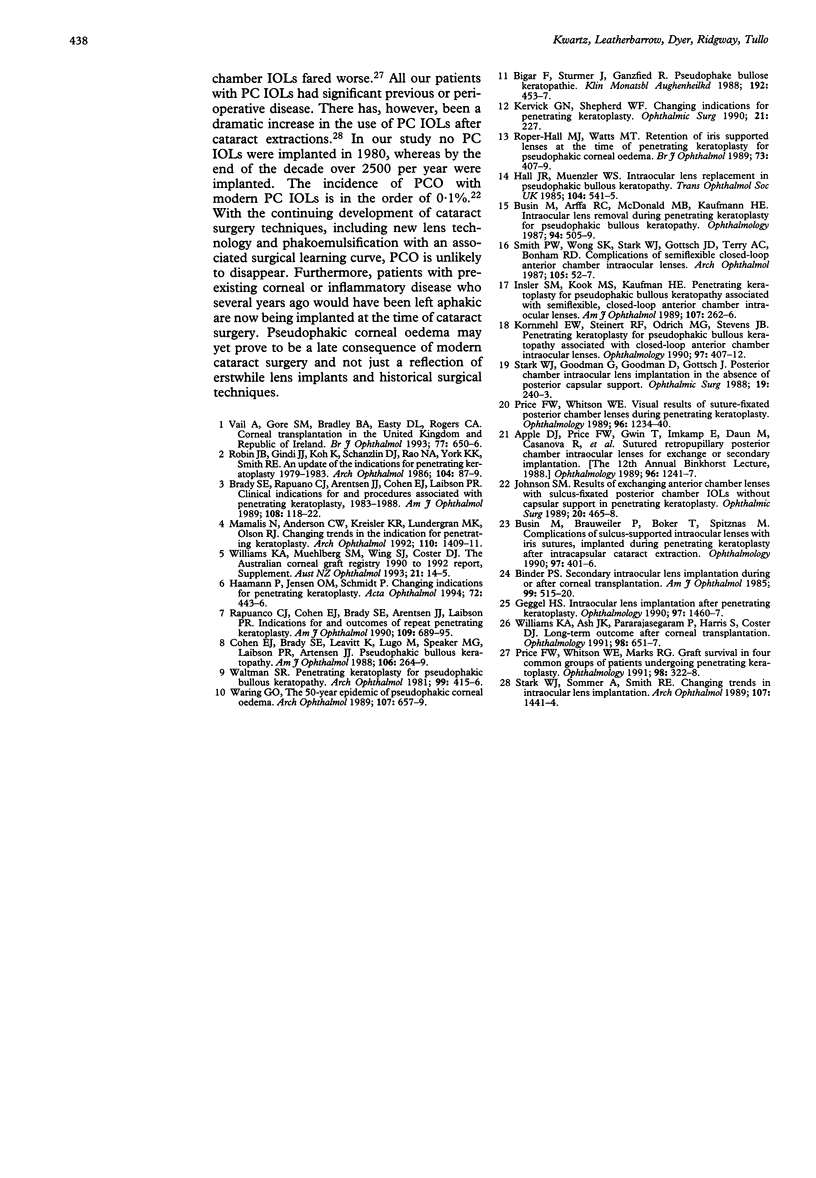Abstract
AIMS--The study was designed to investigate the results of penetrating keratoplasty (PK) for pseudophakic corneal oedema (PCO). METHODS--Retrospective analysis of 80 consecutive patients (82 eyes) who underwent PK for PCO between the years 1980-1992 with a minimum follow up of 12 months. RESULTS--PKs for PCO have accounted for as many as 20% of all grafts performed in the hospital in recent years. The interval between cataract extraction and PK ranged from 6 to 161 months (mean 51 months). The intraocular lens was removed in 45 (55%), left in situ in 30 (37%), and exchanged in seven (8%) of cases respectively. Of the intraocular lenses involved 62% were iris supported, 31% angle supported, and 7% were posterior chamber lenses. Actuarial analysis shows graft survival to be 91% at 1 year and 86% at 2 years after surgery. The likelihood of graft survival was significantly enhanced by removal of the intraocular lens (p < 0.01). A corrected Snellen visual acuity worse than 6/60 was present in 36% of patients with a clear corneal graft. Ocular comfort was achieved in all patients with a clear corneal graft. CONCLUSION--PK for PCO resulted in a disappointing visual result in a large proportion of patients. PK was, however, successful in relieving pain and corneal ulceration when present.
Full text
PDF



Selected References
These references are in PubMed. This may not be the complete list of references from this article.
- Apple D. J., Price F. W., Gwin T., Imkamp E., Daun M., Casanova R., Hansen S., Carlson A. N. Sutured retropupillary posterior chamber intraocular lenses for exchange or secondary implantation. The 12th annual Binkhorst lecture, 1988. Ophthalmology. 1989 Aug;96(8):1241–1247. doi: 10.1016/s0161-6420(89)32745-x. [DOI] [PubMed] [Google Scholar]
- Bigar F., Stürmer J., Ganzfried R. Pseudophake bullöse Keratopathie. Klin Monbl Augenheilkd. 1988 May;192(5):453–457. doi: 10.1055/s-2008-1050150. [DOI] [PubMed] [Google Scholar]
- Binder P. S. Secondary intraocular lens implantation during or after corneal transplantation. Am J Ophthalmol. 1985 May 15;99(5):515–520. doi: 10.1016/s0002-9394(14)77948-6. [DOI] [PubMed] [Google Scholar]
- Brady S. E., Rapuano C. J., Arentsen J. J., Cohen E. J., Laibson P. R. Clinical indications for and procedures associated with penetrating keratoplasty, 1983-1988. Am J Ophthalmol. 1989 Aug 15;108(2):118–122. doi: 10.1016/0002-9394(89)90003-2. [DOI] [PubMed] [Google Scholar]
- Busin M., Arffa R. C., McDonald M. B., Kaufman H. E. Intraocular lens removal during penetrating keratoplasty for pseudophakic bullous keratopathy. Ophthalmology. 1987 May;94(5):505–509. doi: 10.1016/s0161-6420(87)33427-x. [DOI] [PubMed] [Google Scholar]
- Busin M., Brauweiler P., Böker T., Spitznas M. Complications of sulcus-supported intraocular lenses with iris sutures, implanted during penetrating keratoplasty after intracapsular cataract extraction. Ophthalmology. 1990 Apr;97(4):401–406. doi: 10.1016/s0161-6420(90)32570-8. [DOI] [PubMed] [Google Scholar]
- Cohen E. J., Brady S. E., Leavitt K., Lugo M., Speaker M. G., Laibson P. R., Arentsen J. J. Pseudophakic bullous keratopathy. Am J Ophthalmol. 1988 Sep 15;106(3):264–269. doi: 10.1016/0002-9394(88)90359-5. [DOI] [PubMed] [Google Scholar]
- Geggel H. S. Intraocular lens implantation after penetrating keratoplasty. Improved unaided visual acuity, astigmatism, and safety in patients with combined corneal disease and cataract. Ophthalmology. 1990 Nov;97(11):1460–1467. [PubMed] [Google Scholar]
- Haamann P., Jensen O. M., Schmidt P. Changing indications for penetrating keratoplasty. Acta Ophthalmol (Copenh) 1994 Aug;72(4):443–446. doi: 10.1111/j.1755-3768.1994.tb02793.x. [DOI] [PubMed] [Google Scholar]
- Hall J. R., Muenzler W. S. Intraocular lens replacement in pseudophakic bullous keratopathy. Trans Ophthalmol Soc U K. 1985;104(Pt 5):541–545. [PubMed] [Google Scholar]
- Johnson S. M. Results of exchanging anterior chamber lenses with sulcus-fixated posterior chamber IOLs without capsular support in penetrating keratoplasty. Ophthalmic Surg. 1989 Jul;20(7):465–468. [PubMed] [Google Scholar]
- Kervick G. N., Shepherd W. F. Changing indications for penetrating keratoplasty. Ophthalmic Surg. 1990 Mar;21(3):227–227. [PubMed] [Google Scholar]
- Kornmehl E. W., Steinert R. F., Odrich M. G., Stevens J. B. Penetrating keratoplasty for pseudophakic bullous keratopathy associated with closed-loop anterior chamber intraocular lenses. Ophthalmology. 1990 Apr;97(4):407–414. doi: 10.1016/s0161-6420(90)32565-4. [DOI] [PubMed] [Google Scholar]
- MacRae S., Rich L., Phillips D., Bedrossian R. Diurnal variation in vision after radial keratotomy. Am J Ophthalmol. 1989 Mar 15;107(3):262–267. doi: 10.1016/0002-9394(89)90310-3. [DOI] [PubMed] [Google Scholar]
- Mamalis N., Anderson C. W., Kreisler K. R., Lundergan M. K., Olson R. J. Changing trends in the indications for penetrating keratoplasty. Arch Ophthalmol. 1992 Oct;110(10):1409–1411. doi: 10.1001/archopht.1992.01080220071023. [DOI] [PubMed] [Google Scholar]
- Price F. W., Jr, Whitson W. E., Marks R. G. Graft survival in four common groups of patients undergoing penetrating keratoplasty. Ophthalmology. 1991 Mar;98(3):322–328. doi: 10.1016/s0161-6420(91)32292-9. [DOI] [PubMed] [Google Scholar]
- Price F. W., Jr, Whitson W. E. Visual results of suture-fixated posterior chamber lenses during penetrating keratoplasty. Ophthalmology. 1989 Aug;96(8):1234–1240. doi: 10.1016/s0161-6420(89)32760-6. [DOI] [PubMed] [Google Scholar]
- Rapuano C. J., Cohen E. J., Brady S. E., Arentsen J. J., Laibson P. R. Indications for and outcomes of repeat penetrating keratoplasty. Am J Ophthalmol. 1990 Jun 15;109(6):689–695. doi: 10.1016/s0002-9394(14)72437-7. [DOI] [PubMed] [Google Scholar]
- Robin J. B., Gindi J. J., Koh K., Schanzlin D. J., Rao N. A., York K. K., Smith R. E. An update of the indications for penetrating keratoplasty. 1979 through 1983. Arch Ophthalmol. 1986 Jan;104(1):87–89. doi: 10.1001/archopht.1986.01050130097029. [DOI] [PubMed] [Google Scholar]
- Roper-Hall M. J., Watts M. T. Retention of iris supported intraocular lenses at the time of penetrating keratoplasty for pseudophakic corneal oedema. Br J Ophthalmol. 1989 Jun;73(6):407–409. doi: 10.1136/bjo.73.6.407. [DOI] [PMC free article] [PubMed] [Google Scholar]
- Smith P. W., Wong S. K., Stark W. J., Gottsch J. D., Terry A. C., Bonham R. D. Complications of semiflexible, closed-loop anterior chamber intraocular lenses. Arch Ophthalmol. 1987 Jan;105(1):52–57. doi: 10.1001/archopht.1987.01060010058031. [DOI] [PubMed] [Google Scholar]
- Stark W. J., Goodman G., Goodman D., Gottsch J. Posterior chamber intraocular lens implantation in the absence of posterior capsular support. Ophthalmic Surg. 1988 Apr;19(4):240–243. [PubMed] [Google Scholar]
- Stark W. J., Sommer A., Smith R. E. Changing trends in intraocular lens implantation. Arch Ophthalmol. 1989 Oct;107(10):1441–1444. doi: 10.1001/archopht.1989.01070020515030. [DOI] [PubMed] [Google Scholar]
- Vail A., Gore S. M., Bradley B. A., Easty D. L., Rogers C. A. Corneal transplantation in the United Kingdom and Republic of Ireland. Br J Ophthalmol. 1993 Oct;77(10):650–656. doi: 10.1136/bjo.77.10.650. [DOI] [PMC free article] [PubMed] [Google Scholar]
- Waltman S. R. Penetrating keratoplasty for pseudophakic bullous keratopathy. Visual results. Arch Ophthalmol. 1981 Mar;99(3):415–416. doi: 10.1001/archopht.1981.03930010417002. [DOI] [PubMed] [Google Scholar]
- Waring G. O., 3rd The 50-year epidemic of pseudophakic corneal edema. Arch Ophthalmol. 1989 May;107(5):657–659. doi: 10.1001/archopht.1989.01070010675025. [DOI] [PubMed] [Google Scholar]
- Williams K. A., Ash J. K., Pararajasegaram P., Harris S., Coster D. J. Long-term outcome after corneal transplantation. Visual result and patient perception of success. Ophthalmology. 1991 May;98(5):651–657. doi: 10.1016/s0161-6420(91)32238-3. [DOI] [PubMed] [Google Scholar]


